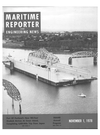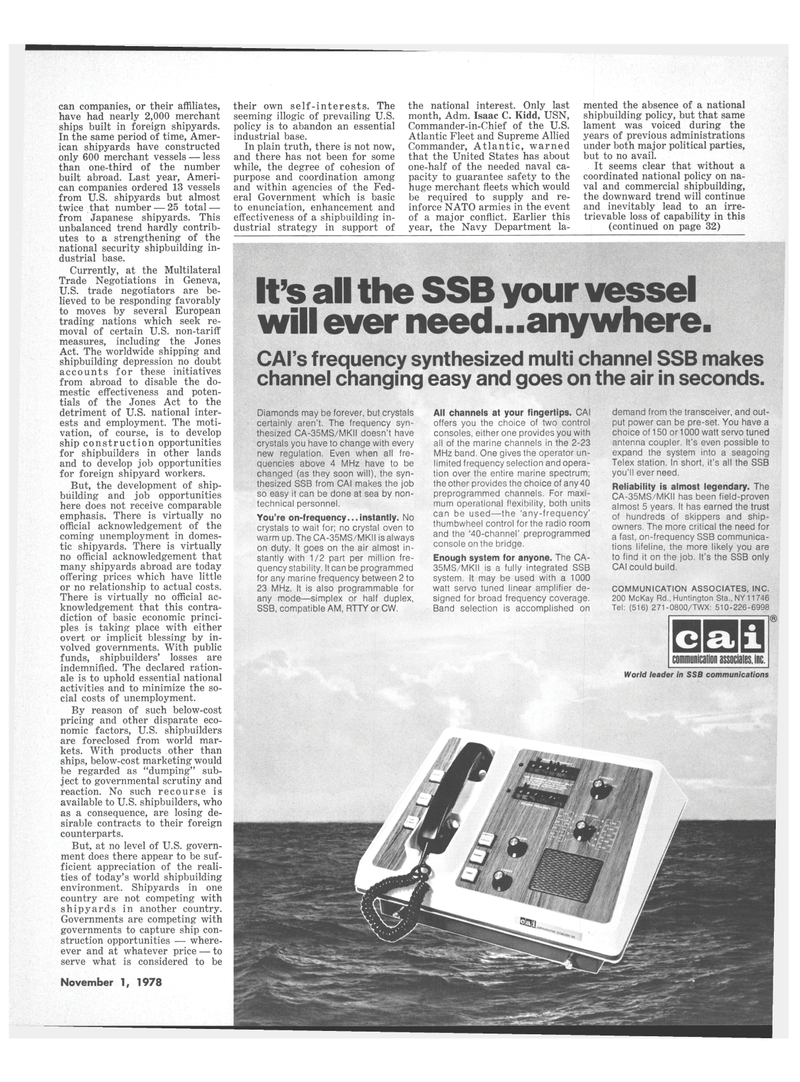
Page 35: of Maritime Reporter Magazine (November 1978)
Read this page in Pdf, Flash or Html5 edition of November 1978 Maritime Reporter Magazine
can companies, or their affiliates, have had nearly 2,000 merchant ships built in foreign shipyards.
In the same period of time, Amer- ican shipyards have constructed only 600 merchant vessels — less than one-third of the number built abroad. Last year, Ameri- can companies ordered 13 vessels from U.S. shipyards but almost twice that number — 25 total — from Japanese shipyards. This unbalanced trend hardly contrib- utes to a strengthening of the national security shipbuilding in- dustrial base.
Currently, at the Multilateral
Trade Negotiations in Geneva,
U.S. trade negotiators are be- lieved to be responding favorably to moves by several European trading nations which seek re- moval of certain U.S. non-tariff measures, including the Jones
Act. The worldwide shipping and shipbuilding depression no doubt accounts for these initiatives from abroad to disable the do- mestic effectiveness and poten- tials of the Jones Act to the detriment of U.S. national inter- ests and employment. The moti- vation, of course, is to develop ship construction opportunities for shipbuilders in other lands and to develop job opportunities for foreign shipyard workers.
But, the development of ship- building and job opportunities here does not receive comparable emphasis. There is virtually no official acknowledgement of the coming unemployment in domes- tic shipyards. There is virtually no official acknowledgement that many shipyards abroad are today offering prices which have little or no relationship to actual costs.
There is virtually no official ac- knowledgement that this contra- diction of basic economic princi- ples is taking place with either overt or implicit blessing by in- volved governments. With public funds, shipbuilders' losses are indemnified. The declared ration- ale is to uphold essential national activities and to minimize the so- cial costs of unemployment.
By reason of such below-cost pricing and other disparate eco- nomic factors, U.S. shipbuilders are foreclosed from world mar- kets. With products other than ships, below-cost marketing would be regarded as "dumping" sub- ject to governmental scrutiny and reaction. No such recourse is available to U.S. shipbuilders, who as a consequence, are losing de- sirable contracts to their foreign counterparts.
But, at no level of U.S. govern- ment does there appear to be suf- ficient appreciation of the reali- ties of today's world shipbuilding environment. Shipyards in one country are not competing with shipyards in another country.
Governments are competing with governments to capture ship con- struction opportunities — where- ever and at whatever price — to serve what is considered to be
November 1, 1978 their own self-interests. The seeming illogic of prevailing U.S. policy is to abandon an essential industrial base.
In plain truth, there is not now, and there has not been for some while, the degree of cohesion of purpose and coordination among and within agencies of the Fed- eral Government which is basic to enunciation, enhancement and effectiveness of a shipbuilding in- dustrial strategy in support of the national interest. Only last month, Adm. Isaac C. Kidd, USN,
Commander-in-Chief of the U.S.
Atlantic Fleet and Supreme Allied
Commander, Atlantic, warned that the United States has about one-half of the needed naval ca- pacity to guarantee safety to the huge merchant fleets which would be required to supply and re- inforce NATO armies in the event of a major conflict. Earlier this year, the Navy Department la- mented the absence of a national shipbuilding policy, but that same lament was voiced during the years of previous administrations under both major political parties, but to no avail.
It seems clear that without a coordinated national policy on na- val and commercial shipbuilding, the downward trend will continue and inevitably lead to an irre- trievable loss of capability in this (continued on page 32)
It's all the SSB your vessel will ever need...any where.
CAI's frequency synthesized multi channel SSB makes channel changing easy and goes on the air in seconds.
Diamonds may be forever, but crystals certainly aren't. The frequency syn- thesized CA-35MS/MKII doesn't have crystals you have to change with every new regulation. Even when all fre- quencies above 4 MHz have to be changed (as they soon will), the syn- thesized SSB from CAI makes the job so easy it can be done at sea by non- technical personnel.
You're on-frequency... instantly. No crystals to wait for; no crystal oven to warm up. The CA-35MS/MKII is always on duty. It goes on the air almost in- stantly with 1/2 part per million fre- quency stability. It can be programmed for any marine frequency between 2 to 23 MHz. It is also programmable for any mode—simplex or half duplex,
SSB, compatible AM, RTTY or CW.
All channels at your fingertips. CAI offers you the choice of two control consoles, either one provides you with all of the marine channels in the 2-23
MHz band. One gives the operator un- limited frequency selection and opera- tion over the entire marine spectrum; the other provides the choice of any 40 preprogrammed channels. For maxi- mum operational flexibility, both units can be used—the 'any-frequency' thumbwheel control for the radio room and the '40-channel' preprogrammed console on the bridge.
Enough system for anyone. The CA- 35MS/MKII is a fully integrated SSB system. It may be used with a 1000 watt servo tuned linear amplifier de- signed for broad frequency coverage.
Band selection is accomplished on demand from the transceiver, and out- put power can be pre-set. You have a choice of 150 or 1000 watt servo tuned antenna coupler. It's even possible to expand the system into a seagoing
Telex station. In short, it's all the SSB you'll ever need.
Reliability is almost legendary. The
CA-35MS/MKII has been field-proven almost 5 years. It has earned the trust of hundreds of skippers and ship- owners. The more critical the need for a fast, on-frequency SSB communica- tions lifeline, the more likely you are to find it on the job. It's the SSB only
CAI could build.
COMMUNICATION ASSOCIATES, INC. 200 McKay Rd„ Huntington Sta., NY 11746
Tel: (516) 271-0800/TWX: 510-226-6998 leg a a j communication associates, inc.
World leader in SSB communications

 34
34

 36
36
